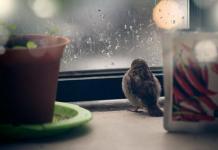The building materials market offers a wide range finishing materials, the use of which allows you to realize an unlimited number of variations in the design of the walls of the room.
The leader among materials for wall decoration is still wallpaper, but their production technology does not stand still.
New times require manufacturers to have a creative approach and invent new and original methods finishing. This is how not only new types of wallpaper appear, but also different ways their sticking.
Traditional methods are still used, but the method of combining wallpaper is rapidly becoming fashionable. Moreover, the process of combining occurs not only in the color scheme, but also in terms of combining wallpapers of different types and structures. Therefore, for example, now no one will be surprised by wallpapering two types in the living room or in the hall.
Why do we use this particular room as an example? It's very simple. After all, she is the main one in the house. She meets and receives guests. It is the living room that becomes a wonderful platform for family celebrations and get-togethers with friends. Therefore, everyone is trying to decorate this room as creatively as possible.
 Options for gluing two types of wallpaper in the living room, photo
Options for gluing two types of wallpaper in the living room, photo The process of combining wallpaper in the living room is not as simple as it seems at first glance. This or that interior looks very beautiful and creates the impression of ease in its creation. But in order to do something like this, you need to know how to hang two types of wallpaper in the room, and what rules form the basis for this process.
Without knowing the rules, you can make certain mistakes, then not only will the appearance room, but also the degree of comfort, perception of the size of the room.
Therefore, you should approach combining wallpaper with the utmost seriousness and pay attention to the layout of coverings with different textures and patterns.
 Design for wallpapering two types of wallpaper in the living room, photo
Design for wallpapering two types of wallpaper in the living room, photo Combination in the hall: defining goals
Before hanging two types of wallpaper in their living room, each person thinks about whether he needs such a solution, which combination is best, what the result will be, etc.? Such questions are completely obvious. Let's try to answer them.
First, you need to realize that the main goal of such a decision is to obtain a certain decorative effect . And he will always be. It all depends on what is closest to your liking. For example, calmer and more discreet wallpaper will help create more interesting and bright accents, motives in the room. And the dark ones not only steal space, but quite often oppress, put moral pressure, and create a feeling of discomfort.

Secondly, the combination of two types of wallpaper is wonderful possibility of space zoning. By choosing the right shades, you can very easily divide the living room area into sectors (zones). Traditionally, contrasting wallpapers are selected for such purposes. Companion wallpapers from the same collection are often used.
As an option, and this will also be good, you can choose wallpaper that is similar in color. The “zest” will be added by the different designs depicted on the stripes.
Thirdly, the presence of two types of wallpaper in the living room is a good chance to hide flaws in the interior. Combining them will help create a distracting design and “hide” a defect that is undesirable for someone else’s eye to see. In such a situation, wallpaper with a relief structure will help.
Main - take into account lighting and choose the right shade of wallpaper. Each shade will behave differently in different lighting. Therefore, to cope with the task, be sure to take these nuances into account.

Having familiarized ourselves with the main goals, we understand that various options Pasting two types of wallpaper in the living room provides a solution specific task. That's why combined wallpaper for the hall - very good option wall decoration.
How to hang two types of wallpaper in the living room: basic rules

Let's imagine that you have studied everything about gluing two types of wallpaper in the living room, consulted with experts, and selected required material and have done the wallpapering of the room, but you realize that something is wrong, as if you got a slightly different result than you expected.
The situation is not the best, so we suggest that you familiarize yourself in advance and follow the basic rules for gluing two types of wallpaper:

Pay attention! You have absolutely no skills in planning a room design, and expert advice doesn’t help? Is the combination of selected shades in doubt? Don't be upset: there is a way out. Use photo wallpaper.
It is desirable that the color scheme of the selected photo panel includes a set of several shades that are in harmony with each other.

Combine color and pattern
Is it easy to find good combination wallpaper of two colors? In fact, it's all up to you. If you have a sense of taste, then this will not be difficult to do. If you doubt that you are on the right path, then it is better to turn to specialists.
Since combined wallpaper for the hall is designed to focus attention (place emphasis) on specific surface or zone, it’s worth thinking in advance which zone you plan to highlight to attract attention. Give preference to wallpaper with bright colors background or catchy patterns.
 Pasting two types of wallpaper in the living room, photo
Pasting two types of wallpaper in the living room, photo But, having chosen catchy wallpaper, remember that you still need to somehow dilute the overall atmosphere in order to muffle the contrast. The room should not turn into a bright booth. The best and easiest option is to choose a calm shade.
Pay attention! We do not recommend using it on the walls of the hall different elements. They should be similar. Something radically different will ruin general view, And perfect combination coatings on the walls cannot be achieved. Therefore, you can choose patterns of the same or similar themes, similar surface texture, similar tones from the same range of shades.

Let's talk in more detail about thematic patterns. There are three types of ornaments:
- classical;
- geometric;
- floral.
Any of these types goes well with wallpaper of the same tone or with wallpaper of light shades with barely noticeable stripes.
Wallpaper with a plant or floral composition can be combined well with wallpaper that imitates, for example, wood, plaster or stone, that is, natural materials.
If you prefer wallpaper with a geometric pattern/ornament or stripes, then pair it with wallpaper with abstraction.

Combined wallpaper for the hall will look great if you alternate them with each other - strip of wallpaper No. 1, strip of wallpaper No. 2, strip of wallpaper No. 1, etc. This way you will not create an emphasis on a certain area, but will add a kind of “zest” to the overall perception of the room.
For ledges and niches in the living room, a vertical combination of wallpaper is ideal different colors. In addition to this option, photo wallpapers with landscapes are often used in the hall.
If you decide to combine wallpaper horizontally, then use a darker shade of wallpaper for the lower part. In this case, dividing wallpaper is often done using skirting boards or moldings.

To easily choose the shade of wallpaper for the living room, consider the following points: the layout of the living room and its area, the style of the room and the degree of illumination of the room.
Helps create a warm atmosphere in the room soft shades: yellow, beige, blue, light green, peach.

Blue or cyan, light purple or gray colors will help you relax. Shimmers, for example, in sand, blue or pink flowers will help emphasize the harmony and airy lightness of the room.
Considering the above, it becomes clear that the design of wallpapering in the two types of wallpaper in the hall will depend only on the choice of the home owner. But that's not all when it comes to wallpaper combinations in the living room. Next we will talk about textured coatings.
We advise you to study the basic rules and see all the secrets and subtleties of creating spectacular and beautifully combined combinations for walls in rooms.
Read about photo wallpapers that expand the space in the interior, and see photos: original finish for stylish and modern rooms.
Combination and textured coatings
IN lately Textured coatings that are intended for painting are becoming very popular. Such materials are very widely used. Such wallpaper, for example, is very easy and convenient to use not only for pasting walls, but also for ceilings. The result, of course, is a perfect combination.
Note that if you use textured coatings, there will be fewer problems with replacing them than with conventional wallpaper, since their “life” is much longer. And repainting is easier than gluing it again.
Today the most common patterns textured wallpaper- these are stripes different thicknesses and orientations (diagonal, horizontal, vertical or chaotic), classic patterns, abstract strokes, floral and plant motifs.

Pay attention! Good in duet with textured coating Liquid wallpaper that matches the color will look great. Use “texture” to design various ledges and niches, columns.
Using textured and liquid wallpaper is a good option, but remember that the most practical is a combination regular wallpaper.
Pasting and types of materials
We ended the previous small section with the fact that it is best to use ordinary wallpaper for combining. But what about combining wallpapers? different types? For example, non-woven wallpaper made from paper, vinyl or fabric covered.
Firstly, such a combination will require more attention from you. Secondly, gluing different types of wallpaper will take more time, because each type has its own characteristics when gluing, including impregnation and drying time.
 Wallpaper sticker of two types in the living room, photo
Wallpaper sticker of two types in the living room, photo As a result, we will need glue for the sticker different types wallpaper You can also use a universal type of glue, but before making the final decision and buying such glue, consult with specialists. Universal things are not always so universal. Maybe it’s still worth buying specialized glue?
The most difficult duo when gluing two types of wallpaper will be the following pair: standard wallpaper+ textile coverings. The joints with this combination cannot be hidden, so moldings, borders and baseboards should be used.

By combining, we create harmony
The main task of combining two types of wallpaper, as with any repair in general, is an excellent result. This means that as a result we must create a harmonious environment. Achieving such a result will be a little more difficult, but it is possible. Additional accessories and details will only help you complete your plan.

A short summary
Combining wallpaper – exciting activity, but there is something to think about. A various types wallpaper only fuels interest. Many have already been convinced of the originality, practicality and beauty of the interiors of the hall, decorated with the help of combined wall coverings. Make sure you do too!
Our article will conclude with a video that will demonstrate various options for combining two types of wallpaper. Look carefully, maybe the video will give you a suitable idea?
If the ideas from the video weren’t enough for you, the gallery below presents 28 more photos with options for combined wallpapering in the living room:



A thoughtful, beautiful interior of a room is a combination of all its components: walls, ceiling, floor, furniture. Both different textures and colors should be combined.
The most popular wall decoration is wallpapering them.
The modern construction market is filled great variety of this material.
But the more types of wallpaper are presented in the store, the more difficult it is to make a choice.
Today we’ll talk about some basic principles for selecting wallpaper and combining several types of wallpaper in one room.
Manufacturers produce the material in collections that feature wallpaper companions. As a rule, they are united by texture and a certain color scheme. Combined wallpapers from one collection can be plain (two, three or more colors), striped or patterned, where all the same colors are present.
In the catalogs, in addition to the samples themselves, you can see examples of combining wallpaper in various rooms in the form of photographs of interiors. This makes the choice somewhat easier.

But the photographs, as a rule, always show rooms of impressive size, so be careful and careful when purchasing the samples you like.
How to combine wallpaper correctly?
To achieve the most interesting interior design, you need to know some rules:
- vertical stripes visually raise the ceiling;
- horizontal stripes “expand” the space, but “lower” the ceiling;
- wallpaper with large drawing suitable for large premises, for example, for a living room, in a small room (kitchen or hallway) they will lead to the opposite effect - they will “reduce” the space;
- small pattern - on the contrary, it is suitable for small rooms; in a room with a large wall area it will get lost;
- For small rooms and rooms with insufficient lighting, choose wallpaper in light shades, which in turn should be lighter than the floor;
- When covering walls with wallpaper from different collections, take into account their thickness (it should be the same, since the sheets are glued end-to-end);
- When choosing two wallpaper colors for one room, make sure they are compatible (use the color wheel).
If in doubt, seek help from professional designers interiors. If you have skills in working in 3D programs, then build a model of the room in which you are going to do repairs and wallpaper, and experiment with various materials and color compositions.
Options for covering walls with different wallpapers
Dividing the room into zones

Using wallpaper of different colors or patterns, you can divide the room into two or more zones.


For example, highlight a recreation area, work area or play area in the children's room. It is beneficial to highlight the most significant part of the living space.


One stripe, two stripes
You can cover the walls with two types of wallpaper, alternating the canvases with each other. The stripes can be in the same color scheme and differ only in pattern, or create a contrasting alternation of light and dark inserts.

Increasingly found in modern interiors horizontally pasted striped wallpaper, they create dynamics in the room. But don’t get carried away with them, use them fragmentarily, combining them with plain canvases. Keep in mind the visual effect of horizontal stripes: expanding space but lowering ceilings.


Classic is always in fashion
Lovers classic interiors can safely use horizontal division of walls with two types of wallpaper using a border: paper, polyurethane or wood.

If the ceilings in the room are not high enough, then wallpaper of darker shades should be glued from below, and light ones - from above. This will visually stretch the room. For rooms with high ceilings suitable option exactly the opposite.


Niche design
You can decorate niches or protruding parts of plasterboard structures with wallpaper that differs from the color of the main walls of the room.

Using wallpaper of different colors and textures, you can advantageously emphasize the design solution.

Smooth flow
An interesting solution is to wallpaper part of the wall and ceiling, when the strip seems to flow from one surface to another. This method is used to emphasize any part of the room. So in the bedroom you can select the place where the bed should be installed.

This is unusual design solution breaks the geometry of space and is to the taste of many.

Pasting walls and ceilings
It is believed that wallpapering ceilings is no longer fashionable. However, you can use " liquid wallpaper" Using this material, you can decorate both walls and ceilings by choosing compositions of colors that harmonize with each other.

patchwork quilt
Patchwork sewing in the “patchwork” style can be imitated on the walls by pasting them with fragments of wallpaper with different patterns. The first rule is the compatibility of paintings, the second is accuracy and precision. Such work must be performed by qualified craftsmen, but the result is worth it.

Recently, you can find wallpaper on sale that already imitates a patchwork quilt, but the squares on them are smaller. By creating a composition yourself, you will be able to calculate the report required for your room and select suitable rolls of wallpaper.

From simple to complex
It would seem that there is nothing difficult in hanging wallpaper, even if it is of two colors. However, using ordinary wallpaper you can create complex compositions with smooth joints.

To do this you will need a knife with a very sharp blade. The overlapped sheets are cut according to the template, the edges are moved apart, the excess is removed and glued end-to-end again. The work is quite labor intensive.
Aerobatics
To create individual premium interiors, architects and designers advise purchasing designer wallpaper. Or order them from individually, offering your own design, acceptable in the created interior.


No less interesting solution is a combination of ordinary roll materials with photo wallpaper. Thus, the rooms acquire additional depth.

It is important to remember that when gluing two different types of wallpaper end-to-end, their thickness should be the same. If the selected samples differ in thickness, then the joints can be decorated with molding, as if framing the picture with a frame. This wall design can be found in classic interiors.
Experiment, look for your own image, don’t be afraid of bright or dark colors. But stick to the rules established by practice.
One of the most important roles in design of any room playing compilation wallpaper . This technique makes it possible to significantly transform interior . If necessary, correct planning deficiencies are carried out wallpapering of two types . For example, with different textures, color, pattern. Options there can be a lot, but it is always necessary to take into account a whole list of conditions.
Creating practical, functional and beautiful interior- the issue is a priority.
Combining and gluing two types of wallpaper cannot be done without observing a number of rules that are given in the table.

The design of the walls of a room largely shapes the entire image of the room, its character, and mood.
| Rule | Description | Advice |
| Taking ceiling heights into account | The height of the ceiling largely determines the requirements for the pattern on the wallpaper and its texture. | Vertical stripes increase height. Stripes can only be distributed over one or two walls. If the height of the walls less than 2.5 meters, it is recommended to choose light wallpaper . They can be either plain or with small drawings. Interior with ceilings over 3 meters require a different approach to design . Great solution will wallpaper with large patterns , stretched horizontally. Horizontal zoning is acceptable walls |
| Room area | The dimensions of the space also play an important role in the selection. | For spacious rooms you can choose bright, saturated colors. This way will visually reduce the area, make a room more cozy. It will look good combination of two types of wallpaper : plain and with ornaments. Horizontal lines or other patterns are not recommended.
For small rooms on the contrary, light ones will be required walls . Small discreet is allowed drawing. |
| Geometry | Wall ratio should also be taken into account. | Fix long narrow room can fix it wallpapering of two types . For example, for smaller walls glue light, plain ones wallpaper . At the same time, they should go long in the corners. The rest of the space is filled wallpaper with an unobtrusive pattern. |
| Texture | When gluing two types of wallpaper It is imperative to maintain the integrity of the texture. | When combining, it is necessary to use wallpaper of different thicknesses. If you use different type of wall covering, you should select the adhesive especially carefully. |
| Sunlight | To choose from color combinations influences the number of people entering room sun rays. | Wallpaper in a very bright room should not be monotonously light. They can be diluted with coverings with an ornament or some image on a long light wall. |
Combination methods
There are also several ways to combine such material as wallpaper . The most important thing in choosing is to clearly imagine the end result. design.

The choice of modern finishing materials is incredibly wide, the range in cost is also wide - in a modern store it’s easy to get confused.
So, let's look at effective methods.

- Stripes placed relatively rarely, but on all walls of the room at the same interval;
- Various stripes in color and pattern also permitted, but care must be taken to avoid absurdity design (you should take everything from the same collection);
- It is possible to combine three types of wallpaper from one series at once;
- If the wallpaper has stripes go to the ceiling, then this will also help do it is visually higher;
- Wallpapering two types from one collection - it's a win-win option, such an interior will always look good.

You can highlight one or another functional area and decorate the walls.

Find suitable option a homeowner with any wallet size can do it.

- Horizontal stripe along the entire perimeter, located at the window sill level;
- In a corridor, the line can be placed at adult eye level, and the separated areas can vary in color;
- The lower third of the wall can cover striped wallpaper , and the remaining area - plain or with small drawing.

The decoration should create a single, harmonious image of the room.

Decorating walls using combinations plain wallpaper – current method registration

- If possible, the different area can be highlighted with a frame;
- You can highlight a niche with a pattern;
- The niche can be covered with contrasting color.

Where else if not in the living room can you indulge in a touch of luxury.

Even in laconic modern interiors this design accent wall able to create a special mood.
- Designers often use method of creating color accents. In this case, there are two methods:
- Distracting attention from a part premises with unsightly elements;
- Drawing attention to some subject interior

This design can increase the degree of originality and elegance of the image of the room.

If you are unsure, it is better to entrust the combination to a professional.
He will definitely be able to select the most suitable room design options . But a beginner in this business can choose ridiculous combinations.
Pairing Basics
It is important to consider that when combined, the coating with the pattern in the base must contain the same shades , same as plain wallpaper. Drawing there may be several species : based on geometric elements, classic patterns or floral motifs.

Any of these options will look good with plain surfaces.
Textured ones are also worthy of special attention. wallpaper , which are becoming increasingly known in modern design . This is a good alternative to liquid wallpaper.
The texture can manifest itself in the following elements: stripes , curls, abstractions, plant elements. This type of wallpaper They are easy to stick and can be painted. They are also great for decorating ceilings.

A significant advantage of this choice is durability and the ability to repaint surfaces.
Correct lighting
Indoor light always plays a major role. It must also be taken into account when selecting wall coverings. If the light is in room little, then about the dark colors like these situations can be forgotten.

You will have to choose from beige, cream, light gray shades.
Light can be distributed zonally. For example, where wallpaper lighter it will be less saturated, in dark areas it will be brighter.When split horizontally walls additional light can be placed around the perimeter of the dark part: along the floor or ceiling.
Wallpaper selection
A guarantee of quality interior – this is a competent choice of finishing materials materials.

For full or partial finishing All types of wallpaper can be used on walls in terms of classification according to technological characteristics.
Manufacturers offer several types of wallpaper , each of which has a number of its own characteristics.
- Paper excellent match with wallpaper all types due to its flexibility. They lie flat even in the most difficult and hard-to-reach places.
- Vinyls are different high density and strength. This perfect choice For walls , prone to mechanical damage. For example, for a corridor. It is better to combine them with paper wallpaper.
- Non-woven wallpaper All designers appreciate its texture. They are the ones who can hide any imperfections on surfaces. walls . At the same time they are great match with wallpaper any quality. The main thing is to carefully apply the pasting.
- Textile ones are quite expensive. This good choice for a bedroom or living room. It is worth noting that they can only be combined with non-woven or paper coverings.
- At first glance, liquid ones resemble decorative plaster. This solution suitable for premises for any purpose. Can be combined with non-woven fabrics wallpaper.

For living rooms, this type of finish can be used for accent surfaces.

Textile wallpaper looks luxurious, has high environmental properties, and is able to “breathe”.
To wallpaper were glued efficiently, it is necessary to perform the following steps during the repair process:
- Make preparations walls which consists of cleaning from old coatings, puttying and priming;
- Prepare glue purchased specifically for the selected type wallpaper;
- Apply glue to wallpaper or walls (do as indicated in the instructions);
- Glue the main ones wallpaper (those that occupy large area);
- When measuring, be sure to leave seam allowances, since when drying wallpaper capable of shrinking slightly in size, which threatens the appearance of a void between stripes;
- You should start gluing from the ceiling, leveling the surface with a special roller;
- Glue wallpaper to combine;
- Trim unnecessary areas of the covering, stick on borders and tapes if necessary.

Following simple rules will provide excellent results.
Designers are always guided by several principles when combining wall coverings. Following the tips below will help you choose a win-win wallpapering options for this or that premises.

Tastefully selected wallpaper will add beauty and comfort to your home.
- Stylish harmonious design can be obtained with combination of light wallpapers coverings of the same collection, but with a bright, saturated drawing.
- Make a room you can make it brighter by highlighting it with wallpaper only one wall.
- When horizontal zoning is necessary, it is necessary to select borders or dividing tapes. Without them design will be unfinished.
- Patchwork is acceptable for children combination . It’s good if the baby chooses for himself wallpaper.
- It is better to combine rich shades with pastel colors.
- Plant elements in some cases overload room.
- Upholstery upholstered furniture, curtains, carpets should be selected taking into account the finishing walls This will allow the interior look stylish and complete.
- Wallpaper , decorating elements and glue are best purchased in one store.
- Pasting corners rooms with contrasting colors allows you to visually align proportions rooms.
- When designing, it is unacceptable to use more than 5 colors.
- For small rooms you can't choose wallpaper with large patterns.
To design You should always approach your home with maximum responsibility, no matter what part of the house or apartment it is. Before starting any work, you need to clearly define the goals that you want to achieve with the help of combining wallpaper.

You need to imagine the final result.
Wall coverings must be chosen carefully; attention, as a rule, is paid not only blossom , but also quality. The accuracy of implementation depends on this ideas . When choosing contrasting combinations, it is recommended to think carefully colors , they should fit together and not be heavy to look at. Contrasting solutions are not recommended for the bedroom.

In any case, this is an interesting, exciting activity that, if taken seriously, will provide excellent results.
A modern method of decorating a living room or bedroom with wallpaper is the active use various colors on several walls. This is a way to add variety to your design and draw attention to a specific part of the room. If necessary, correct planning deficiencies, apply different options wallpapering. There are techniques that help give the interior your own style. To realize the design concept, wallpapers of various textures, shades, and with different patterns are used.
Combination principles
To make the combination look harmonious, you should consider certain parameters. Many wallpapering options are used to mask imperfections in the layout of a kitchen or living room and achieve a certain decorative effect, for example:

Before combining different wallpapers, for example, in a living room or bedroom, you must:
- evaluate the functions and elements of the layout;
- take into account the size and geometry of the room.
Ceiling height
The choice of type of coating, features of the ornament, texture, and color depend on the height of the ceilings. If the walls are below 2.5 m, then calm tones, soft texture and small patterns are chosen. Combining a light background with a weak texture or vertical ornament helps to visually raise the ceiling. You can use an image or stick stripes of different colors, placing them on one or more walls, as can be seen in the photo.

If the ceilings are higher than 3 meters, then a different approach is used. A large, horizontally stretched pattern is selected. It is permissible to use division by color, horizontal combination as in the photo. To ensure that wallpapering in this way is modern, you should carefully select colors and patterns.

Room dimensions
In a spacious room you can safely use fairly saturated colors and/or dark shades. This approach makes it possible to visually reduce its size. When monotonous dark walls do not fit, then you can choose a coating with a large ornament light color - plant patterns, abstraction, geometry. In compact rooms it is strongly recommended to use light shades, perhaps with a weak texture or small pattern. Example for a bedroom under a roof:

The geometry of the room also plays an important role. Sometimes it needs to be visually aligned. If the room is very narrow, and even long, then the gluing option saves the situation, in which light wallpaper. Non-standard layout and wallpaper combination in the hall:

When the entrance is located on the long side, the center of the opposite wall should be covered with a coating of a different color. On the sides, leave the same wallpaper that covers the short ones. The room will be perceived differently, it will not look so narrow and long. Design option for small hall in the photo:

You can also make a small bedroom stylish by properly wallpapering the walls:

Features of choice
When gluing several types of canvases, you should carefully select their texture, quality and thickness. When combining, it is recommended to choose fabrics of the same type. When the wallpaper is joined exclusively at the corners, then you can purchase coatings of different thicknesses and textures. If the canvases are joined on a smooth wall, then these differences highlight the transition. This is shown in the photo of the hall:

In a room well lit by the sun, you can glue dark-colored wallpaper to the wall opposite the window, and light-colored wallpaper to the rest. To make it lighter, just cover the wall opposite the window with light wallpaper.
Existing wallpapering options can be used separately or combined several approaches. It is important to know what effect you need to achieve. Interesting example wallpapering the kitchen with companions:

Vertical combinations
Vertical stripes, which visually increase the height of the room, do not have to be evenly spaced. Today you can cover one wall with striped canvases, the rest can be covered in plain colors or with a modest pattern. Vertical stripes can be safely placed on several walls. They can be placed in the same increments or at different intervals. One option for wallpapering the living room is shown in the photo below.

Stripes may vary in color and pattern. With this combination, texture and quality must match. This type of combination is best done using coverage from the same collection. Many campaigns produce a range of matching patterns, in certain colors. There is an interesting technique that allows you to make the ceiling visually higher. This is to put wallpaper on the ceiling and make a blurry transition. The photo shows a bedroom wallpaper option different wallpapers:

Horizontal division
The technique refers to classical design methods that have been used for a long time. This option is well suited for small rooms where the ceiling height allows. You can divide the room simply with a horizontal strip around the perimeter. The plane is divided into 3 parts, and the line can be located at the bottom, for example, placed from the window sill, or at the top. The strip is sometimes performed at eye level, where different decorative items, but then the rule is broken. This is usually done in corridors and hallways.

Traditionally, the bottom with this division is made darker, the top is lighter, the rule can also be broken. The transition location is determined before gluing, where a line is drawn parallel to the floor. First the top is glued, and then the bottom; the joints can be covered with a border or a special tape, as in the photo.

To traditional methods of wallpapering companions when horizontal division include:
- the bottom (1/3) is covered with striped wallpaper, the top is made plain (or a small pattern is used);
- wallpaper in a small pattern is glued to the bottom (1/3), a large ornament goes to the top (can be covered with plain canvases);
- 2/3 of the bottom is covered with wallpaper with large patterns, the top is plain.
An option for covering the kitchen with two types of wallpaper is shown in the photo:

Color accents
Often in the bedroom, attention is drawn to the bed or the wall opposite it. The photo below shows one of the options.

Forming in the kitchen dining area. This method is often used in studio apartments to visually separate zones of different functionality. Here it is possible to use coatings of different textures and qualities.

The hall can be covered as follows:

For classic interiors, you can decorate the wallpaper in the form of a panel, which is logically limited by a frame. This option is perfect for Provence and country styles. Such panels can be safely placed in the Art Nouveau style, but the frame should be made of wallpaper, where the color and collection must match. As an option, you can paste over the niche. Then the image, pattern, pattern with texture is selected according to the style. It is recommended to use canvases from the same collection. The kitchen wallpaper option is shown in the photo:

The emphasis can be performed:
- a vertical stripe, which is often found with low ceilings;
- horizontal stripe in a high room.
It is more interesting to highlight niches and protrusions in the room with other canvases, turning this detail into a highlight, to add a special personality to the design. Interesting option designing a niche in the bedroom:

Or different wallpapers in the kitchen:

Original design
An original option for wallpapering in the bedroom - using wallpaper inserts. First, you should stick on dim, plain background canvases. Next, you need to make inserts from, for example, non-woven wallpaper. They can be done different sizes and forms:

Combination helps to visually highlight different colors in a room. functional areas. An accent is often used in the living room when the wall behind the TV or fireplace is highlighted in a color that contrasts with the rest in the room. In the photo in the hall there is such an area behind the TV.

You can use a patchwork combination, when the walls of the room are covered only with inserts, without a background. The main thing is that the harmony of materials is maintained when implementing this method. You can glue multi-colored blocks randomly, but you need to combine these inserts into a design or pattern.
Option for wallpapering in the kitchen:

If there are many niches or arches in the room, then they must be used when creating original interior. Designers recommend highlighting and playing up such places. You should glue wallpaper of contrasting colors or bright embossed fabrics:
- if the wallpaper is light, then make the niche dark;
- small main pattern, and decorate the protrusion with a large pattern.
The photographs below show wallpapering in contrasting colors in the living room and bedroom:


Different options for wallpapering a kitchen are shown in the video:
The correct combination of wallpaper of two or more colors in the interior is good idea diversify the space, change the design of the room, the main advantages of combining wallpaper of two colors: it’s cheap, original, fashionable.
Interesting design ideas and tips will help you make any room, even the smallest and darkest, ideal, by combining wallpaper of two colors.
The main point in combining wallpaper of several colors is the right combination wallpaper by color, the usual range of colors and shades will help with this.
Combining wallpaper in the interior is a fairly new trend in the world of renovation and design, but very successful. By combining wallpapers with each other, it turns out interesting view room, it becomes possible to emphasize the advantages and hide the disadvantages of the walls and room. A dark room can be visually brightened, and a room that is too light, on the contrary, can be darkened. Combining wallpaper is not such an easy task; you need to take it seriously and do everything right.
There can be several wallpaper combination options:
- Combining wallpaper by color and shade
- Combining wallpaper according to material;
- Combining wallpaper according to texture.

In all types of wallpaper combinations, you need to maintain the correct color scheme so that the wallpaper has something in common, such as a print, pattern, background or color.
In the first option, this is a combination of wallpaper according to its color and shade. Here it is recommended to use the spectrum of colors and shades and choose more suitable color transitions. The combination of wallpaper by material is no less complex; you can combine wallpaper of several materials, vinyl, paper, wallpaper for painting, non-woven wallpaper, but be sure to take into account the color of this wallpaper. A combination of wallpaper of two texture colors is when wallpaper of several textures and patterns is combined on one wall.
Even more information about choosing the color of wallpaper for decorating a room can be found in the following material:
We make combined wallpaper in rooms
You can combine wallpaper in any room, with any area and lighting. A combination of wallpaper looks much more profitable in large and spacious rooms, because the walls have a large area, allowing you to “accelerate” your imagination and bring your wildest fantasies to life.
But even in small rooms, combined wallpapers of several colors also look good if you maintain the general color scheme and texture of the wallpaper. Combined wallpapers are perfect for covering children's rooms, living rooms, and halls.

In the bedroom, hallway and kitchen, you can also glue combined wallpaper.
Combined wallpapers can be sold ready-made, with combination ideas, but you can make a combination yourself, select the wallpaper:
- By type of materials;
- By color and shade;
- According to the invoice.
The combination of wallpaper colors can have several variations:
- A simple combination, two colors adjacent in the spectrum;
- Complex combination, several colors;
- Bold combination, combination opposite colors across the spectrum.
For a room with a small area, it is better to choose light wallpapers and shades; in a large room, you can experiment with color.
Examples of combinations are very different; when combining wallpaper, the predominance of the main color in the interior implies a combination of it with the main shades.

If you create a room in light and calm colors and in the same color scheme, you can choose the colors adjacent in the spectrum of yellow and green, for example, and their shades. Well, if the room is decorated with basic dark wallpaper, they need to be combined in opposite colors in the spectrum.
When choosing the idea of combining wallpaper in the interior, you need to be guided by some rules that will help you decorate a room beautifully, correctly and tastefully with wallpaper.
To do this you need to know a few rules:
- Choose the color of the wallpaper depending on the area and lighting in the room;
- Don't mix the two bright colors wallpaper in one room;
- Maintain one color scheme;
- Dilute the room with small details of certain colors.
The color of the wallpaper should emphasize the advantages of the room, and focus attention on its shortcomings. Therefore, for a small room we choose light wallpaper, and for a large room, dark wallpaper. Two saturated bright colors even in big room will not find harmony, so combining only two bright colors with each other will not work. If you combine the wallpaper of the two rich colors, then be sure to make transitions using light or even tone wallpaper. In addition, in a room with combined wallpaper, you need to maintain one color scheme, diluting the interior with small interior details.
In one room you can combine up to five colors and shades, otherwise there will be no harmony in the room.
How to glue combined wallpaper
Having decided on color scheme, you can start gluing combined wallpaper, taking into account all the tips and recommendations. Installing combined wallpaper begins with preparing the walls of the room; it is important that the walls are smooth and free of defects. The calculation of wallpaper for a room must be accurate so that you don’t have to search all the stores for a similar color. Next important stage, this is preparing a roll of wallpaper for gluing. If the wallpaper has an ornament or a pattern that requires selection, you need to correctly adjust the cut to the height and width of the room, corners and joints. Mark paired stripes in advance so as not to confuse them with the rest of the wallpaper. This is difficult to do for wallpaper that is combined independently, in separate stripes; here you need to use a construction tape and a level.
Hanging combined wallpaper is also not easy:
- It is necessary to maintain the level of the lines when gluing horizontal, vertical and patchwork wallpaper;
- It is good to glue the joints of the wallpaper;
- Carefully trim the edges of the wallpaper.

Having carefully prepared the materials for work and work surfaces, wallpapering will take a little time and the work will be done.
It is better not to glue combined wallpapers overlapping; you should avoid overlapping one sheet of paper over another and glue the wallpaper end to end.
What role do combined wallpapers play in the interior?
Combined wallpapers are suitable for the most different interiors, as a self-sufficient decoration of a room.
The abundance of wallpaper choices provides a unique opportunity:
- Using wallpaper as an independent decorative element;
- Combination of several styles in one room;
- Distribution of rooms into zones.
When dividing a room into zones using wallpaper, you need to choose correct colors wallpaper for a comfortable stay in these areas.
Options for combining wallpaper for walls (video)
Using wallpaper you can perfectly decorate one-room apartment or huge country house beyond recognition. Combined wallpaper will help highlight positive features premises, hide the imperfections of the room and surfaces, create cozy room and bring your wildest fantasies to life.
Combining wallpaper (photo)


































